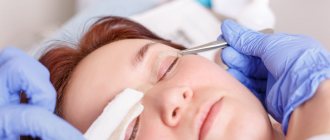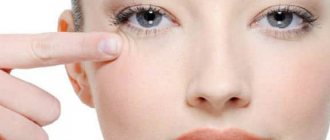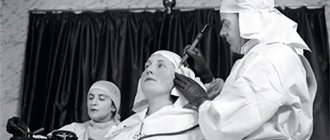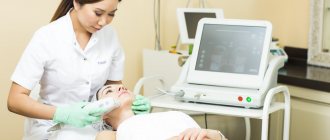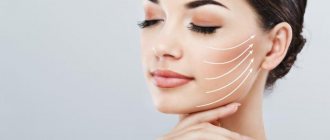In the recent past, in order to achieve a bright anti-aging effect and lose a couple of decades, the well-known circular facelift was used. Just 5-10 years ago this was a classic method, with the help of which only the skin and subcutaneous fat tissue on the face were tightened.
Of course, the effect of such an operation was noticeable to everyone. But, alas, on the other side too - those around them saw not only smooth skin without wrinkles, they also saw the effect of a mask on the face, which appeared as a result of skin tension.
The fact is that a circular lift does not affect the muscular frame of the face, but it is this that is responsible for the sagging of the tissues. With age, facial muscles lose elasticity, the skin begins to sag, jowls, nasolabial folds and other unpleasant accompaniments of age appear. To erase all signs of aging from your face, a single circular lift will not help. A comprehensive effect on all tissues and the muscular frame of the face is necessary.
To ensure that your transformation evokes admiring glances, to look as natural as possible and to look 15 years younger without the mask effect, you should pay attention to new, modern methods of plastic surgery.
SMAS-lifting
Modern facelift methods allow the doctor to work in different planes, not only with the skin, but also with deeper soft tissues. The so-called SMAS lift is a lifting that affects not only the skin, but also the subcutaneous, so-called superficial muscular aponeurotic (SMAS) layer. This “deep lift” ensures a complete return of the tissues to the natural position characteristic of a young face and gives the most lasting effect.
SMAS lifting is often used in cases where it is necessary to cope with severe ptosis (drooping) of tissues. As a rule, SMAS lift is recommended for patients over 45 years of age who experience significant age-related changes.
SMAS lifting is a fairly serious operation that is performed under general anesthesia and lasts from 2 to 4 hours. The incision is made in the natural crease behind the ear, making it virtually invisible. After the operation, the patient spends 2-3 days in the hospital, and post-operative recovery takes approximately 2-3 weeks.
Gradually the patient's appearance improves. The final result of the operation is achieved after 2-3 months and lasts for many years.
Indications for use
Surgical facelift surgery is recommended for patients over 35 years of age. The operation allows you to eliminate the following aesthetic defects:
- wrinkles and folds on the forehead and bridge of the nose;
- drooping eyebrows and outer corners of the eyes;
- painting bags, “depletion” of the zygomatic area;
- pronounced nasolabial folds, jowls;
- drooping corners of the mouth, “marionette lines”;
- sagging skin in the submental area, formation of a double chin.
Rehabilitation period
In the first days after the procedure, pain in the operated area is possible, which is easily eliminated with analgesics prescribed by the doctor. During the day after the operation, the patient is under the supervision of a doctor in the hospital, after which she can go home.
The leading side effects in the first 7-10 days after the procedure will be hematomas and swelling of the face. This is a natural tissue reaction that does not require any action and therefore should not bother the patient.
It is important to follow the following recommendations:
- Avoid drinking alcohol, aspirin and smoking in the first days after surgery;
- for 3 months do not visit saunas, baths, solariums and do not be in the open sun;
- refrain from intense physical activity and massage in the operated area.
You can get a facelift in St. Petersburg by contacting the Mediaesthetic clinic. You can choose the optimal procedure method and find out the cost of the operation in consultation with a doctor. Call our managers and arrange an appointment day convenient for you.
Liposuction of the neck and chin
In cases where aesthetic correction of the lower part of the face does not require skin excision, but aesthetic problems are more likely associated with excess adipose tissue, liposuction is usually used. Liposuction of the neck, chin or cheeks is one of the most popular methods for correcting the lower third of the face and neck. This operation allows you to get rid of a double chin and correct jowls. Liposuction not only removes excess fat tissue. In the process of healing and regeneration of subcutaneous connective tissue after liposuction, its elasticity increases, and the skin noticeably contracts and tightens. As a rule, liposuction itself gives an excellent result if the skin of the neck and chin is still quite elastic, and in cases where this is not the case, the surgeon complements it with other types of facelift.
Facial liposuction is a non-invasive operation that takes no more than 30 minutes, but in our clinic it is usually performed under general anesthesia (for greater patient comfort). Excess fat tissue is removed through tiny incisions made under the chin or behind the earlobe. Due to its low morbidity, liposuction is well tolerated, and the rehabilitation period is only a few days.
Contraindications and rehabilitation after facelift
These are the main types of facelift. The specific type of intervention is determined by the doctor depending on the indications and the required depth of intervention. Contraindications to these operations are almost identical with minor differences. These include diseases of internal organs, cardiovascular failure, blood diseases (including bleeding disorders), infectious diseases, exacerbations of chronic diseases, autoimmune diseases (including diabetes), hypertension, and cancer.
In the postoperative period, experts recommend that in the first month (sometimes up to three months) after a facelift, avoid exposure to the sun, solarium, saunas and steam baths, refrain from physical activity, do not lift heavy objects and avoid sharp bends. It is also necessary to follow a decongestant diet so as not to burden the tissues, and to avoid alcoholic beverages and tobacco, which contribute to vasospasm and prevent tissue healing.
Facelift is an operation that, with a qualified approach and following the recommendations of the rehabilitation period, can stop time for many years. A successful facelift operation returns to the patient a tightened oval face, an open youthful look, self-confidence and pleasure from his own reflection in the mirror.
In the following articles we will consider in detail each type of facelift, indications and contraindications for them.
Silhouette Lift
This is a new, improved technique for lifting facial tissue using a system of non-absorbable threads and tissue-fixing cones, which dissolve after the tissue has healed in a new position. The Silhouette Lift technique has been successfully used in our clinic since 2010. This is a non-invasive lift using the latest generation thread system, which allows you to restore youth without scars, swelling and the risk of complications, and fights ptosis (“sliding” of the soft tissues of the face down). Read more... Plastic surgeons at the DoctorPlastic clinic use all the most effective facelift techniques in their practice, selecting the most suitable one for each patient. Over the years of operation of the clinic, our doctors have helped thousands of women beat time and regain their youthful and well-groomed appearance.
Softlifting
Softlifting is a unique injection technique for correcting the middle zone of the face (primarily the molar and nasolabial area). This technology, created by Swedish plastic surgeons at the intersection of plastic surgery and cosmetology, can significantly rejuvenate the middle area of the face and postpone the need for plastic surgery for several years, replacing it with an easy 20-minute procedure, the effect of which lasts on average up to 10 months. (You can find out more information about the methodology here).
DoctorPlastic surgeons always strive to achieve the result you want using the most effective, but gentle and safe methods. If you are planning aesthetic facial correction, contact our clinic, and together we will determine the optimal way to solve your problems.
How do you prepare for rhytidectomy?
At the first stage, together with the plastic surgeon, the patient discusses aesthetic preferences and correction options. Consultation with an anesthesiologist is also necessary. Tell him about allergic reactions to medications.
Before undergoing a facelift surgery, you must undergo the following studies:
- blood - general and biochemical, for viral hepatitis, HIV, syphilis and AIDS;
- electrocardiogram;
- coagulogram - to check the blood coagulation system and prevent bleeding during rhytidectomy;
- fluorography.
You can take all necessary tests at our Institute.
Advantages of the SMAS surgical lift method
Compared to traditional plastic surgery, SMAS lifting affects the deep fibromuscular layers, as a result of which the muscle frame is strengthened and skin turgor is restored. This guarantees a long-lasting result after surgery, because the muscles fixed in the new position hold the soft tissues of the face in the desired position.
The face again acquires clear contours, even deep wrinkles and folds disappear, and the double chin disappears. The skin becomes smooth, even and elastic. The SMAS facelift does not involve stretching the skin, so the shape of the lips and eyes is not distorted, as after a classic circular facelift. Natural facial expressions are completely preserved.
The method is suitable for a wide range of patients - from 35 to 65 years.
Diagnosis and aesthetics of age-related changes in the midface
First of all, age-related changes become noticeable in the upper and middle third of the face. While the lines and wrinkles that bother a patient in the first place are not that difficult to correct, they are almost never significant to the overall architecture of the face. The midface (the area between the lower eyelid and the mouth) is very important for aesthetic perception. More clearly than any other aspect, a person’s youth and health are revealed not by the presence or absence of wrinkles, but by the shape of his face. The beautiful and young central part has a pronounced volume in the cheekbones, rounded shapes and is distinguished by a smooth transition between the lower eyelid and the cheekbone; the nasolabial fold is soft, not pronounced. Due to the sufficient volume of this zone, a young face has the shape of an inverted cone. With age, this facial architecture changes completely - the cheeks become flat, losing volume and shape on top. At the same time, the lower part accumulates fat, the skin sags, the lines of the nasolabial fold are distorted, voids and excess skin form under the eyes.
Types of facelift
Endoscopic
Access is performed using endoscopic equipment through micropunctures in the skin up to 1 cm in diameter, this makes the facelift less traumatic. The surgeon sees the surgical field on the monitor, which allows him to act as accurately and accurately as possible. The minimally invasive nature of the operation shortens and simplifies the rehabilitation period.
Classical
An incision is made with a scalpel along the scalp, from the temple to the earlobe. This access is more traumatic, but is justified with significant age-related changes. With the correct actions of the surgeon and proper care, the marks after a circular lift will not be noticeable to others.
Criteria for assessing age-related changes in the midface
The modern concept of plastic surgery considers the face as a single whole. In particular, the lower eyelids and cheeks are included in the middle zone complex. Therefore, the processes occurring in it must be analyzed precisely in this context in order to obtain a good rejuvenating effect. The middle zone of the face consists of the lower eyelids, cheek and zygomatic areas. As a rule, changes in all these parts of the face are interconnected. To analyze the midface area we consider:
- lower eyelids
the presence of excess skin volumetric changes, the presence of a tear trough the size of the palpebral fissure the position of the lateral angle of the eye the height of the lower eyelid the transition of the eyelid-cheek, eyelid-cheekbone
- volumetric changes in the cheeks and cheekbones
- presence of ptosis or excess skin in this area
- depth of the nasolabial groove
Age-related changes in the midface
With age, the proportions of the face change, the volume from the upper and middle parts of the face moves down, the malar fat, located at a young age above the cheekbone, slides down, causing deformation not only of the cheek, but also of nearby tissues. In this regard, the main task of the surgeon when reconstructing the midface is to move the volume upward, create a high line of cheekbones with sufficient roundness and volume, reduce the length of the lower eyelid, soften the severity of the nasolabial fold, and straighten the tear trough.
How much does a circular facelift cost?
The Institute of Plastic Surgery offers you one of the most affordable prices in Moscow for facelift - from 149,000 rubles. This cost includes all consultations with specialists, preliminary tests and studies, hospital stay, anesthesia and suture materials.
No hidden extras! You can have the operation today and pay for it in installments over 1-2 years using the installment service. Learn more about surgical facelifts - schedule a free consultation with a plastic surgeon at the Institute.
Attention! All aesthetic plastic surgeries and most cosmetic procedures are strictly contraindicated for pregnant and lactating women. We also do not perform surgical interventions on people whose weight exceeds 110 kg.
The main advantages of facial plastic surgery in
- Specialist Gorbunov G.A. has extensive experience in maxillofacial and plastic surgery of the face and eyelids. During this period, he performed more than 500 facelift operations.
- During facial plastic surgery, the clinic uses the most advanced techniques and modern materials, which are selected individually.
- For a more detailed and accurate discussion of the details of the operation and its results, photo modeling is used.
- Operations “facial plastic surgery (facelift), blepharoplasty (eyelid surgery)” are carried out using modern instruments and illuminators.
- In addition to aesthetic and plastic surgeries, our specialist Gorbunov G.A. knows methods of eliminating the consequences of previously unsuccessful operations.

